MARIANI’S
April
6, 2008
NEWSLETTER

"Home" (2007) Photo by Galina Stepanoff-Dargery
NEW! Click esquire.com
to go to my new column at Esquire Magazine.
ARCHIVE: Readers may now access
an
Archive of all past newsletters--each annotated--dating back to July,
2003, by simply clicking on www.johnmariani.com/archive
Restaurant
Index: A complete list of restaurants covered in this newsletter
since 2003. Please
click here.
SUBSCRIBE AND
UN-SUBSCRIBE: You may subscribe anyone you wish
to this newsletter--free of charge--by
clicking here.
In
This Issue
NEW YORK CORNER: Adour Alain Ducasse by John Mariani
AN ELEGY ON THE CLOSING OF WOLFIE COHEN'S RASCAL HOUSE by John Mariani
NOTES FROM THE WINE CELLAR: It’s Not Easy Being a Cult Cabernet--Just Ask Harlan Estate by John Mariani
QUICK BYTES
BALMY DAYS: SAVORING THE FOOD AND DRINK ON TWO
CARIBBEAN ISLANDS
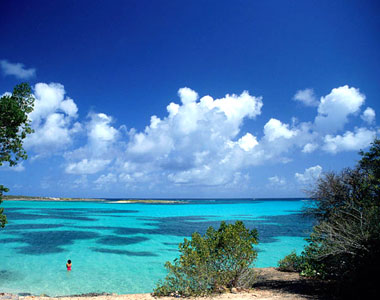
ANGUILLA
Fortunately there are a more than 85 restaurants on the 16-miles long by 3-miles wide island, a short boat ride from St. Maarten’s and St. Bart’s.
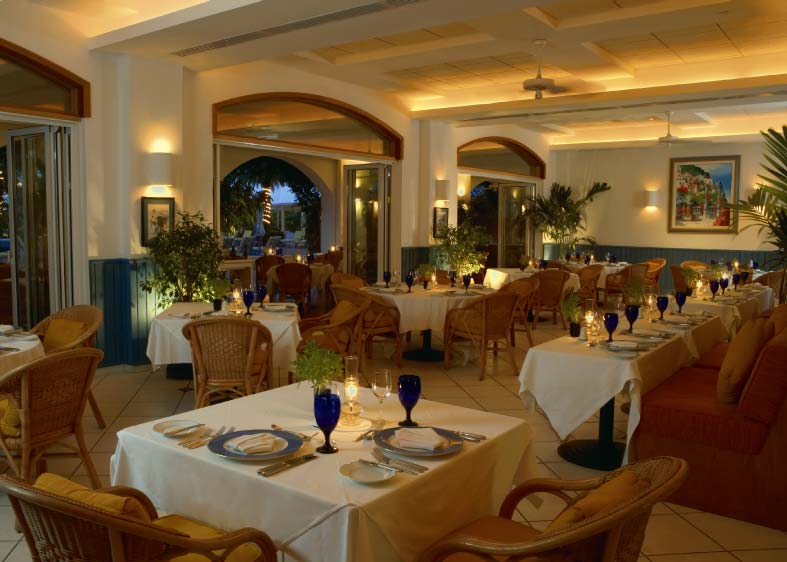 Dining
experiences range from hotel restaurants to independent, locally-run
bistros as
well as beach bar dives. There’s even a restaurant on a small island
specializing in grilled lobster from local waters. Of
course, virtually all villas offer the option of a chef who can prepare
one
meal during a stay or be on call 24/7 as at Sheriva, a
20-room luxury boutique villa hotel.
Dining
experiences range from hotel restaurants to independent, locally-run
bistros as
well as beach bar dives. There’s even a restaurant on a small island
specializing in grilled lobster from local waters. Of
course, virtually all villas offer the option of a chef who can prepare
one
meal during a stay or be on call 24/7 as at Sheriva, a
20-room luxury boutique villa hotel.At CuisinArt Resort & Spa (left) chef Denise Carr draws from the on-premises hydroponic gardens for fresh herbs such as basil, mint and dill to flavor tomatoes, peppers, cucumbers, lettuces and bok choy in dishes inspired by the cuisines of Spain, France, Italy and Greece. The Mediterranean brasserie has a brick oven to turn out roasted local fish.
Tastes of the Caribbean come from the organic gardens where traditional vegetables such as black-eyed peas, peppers, pumpkins and okra are grown alongside melons, avocados, guavas, tamarind, limes, orange and star fruit. These gardens give Chef Carr a reach that few on the island can match.

Grilled local lobster got a touch of sophistication from a piquant passion fruit mustard sauce. Gingered sweet potato and spinach with toasted garlic rounded out the plate in this beach venue built on stilts in Colonial style. Diners sit al fresco on the perimeter porch with the small bar to enjoy what co-owners, chef Carrie Bogar and front-of-the-house-husband Jerry Bogar, call “cuisine of the sun.”
While Veya adds sophistication to the day’s catch, Scilly Cay, the island restaurant (below), and The Dune Preserve where reggae star Bankie Banx serves potent rum punch called "Duneshine" and local-style grilled spicy chicken, ribs and fish. His Dune Preserve is made from parts of old boats and looks like a beach level treehouse made from hurricane detritus.
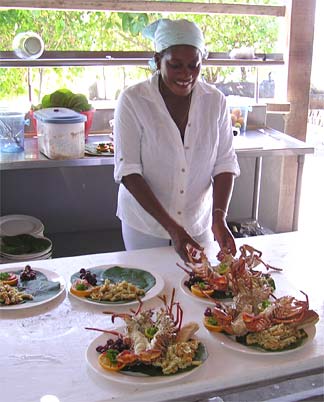 His annual 3-day Moonsplash Music
Festival has become
an internationally-known event.
His annual 3-day Moonsplash Music
Festival has become
an internationally-known event.Take a five-minute ferry ride to get from the dock at
These two local faves are excellent examples of casual beach dining the way locals do it. Lots of sea air, rum punch, palm trees swaying in the breeze, sand between your toes and a great attitude.
PENINSULA PAPAGAYO,

Located on the north Pacific coast of
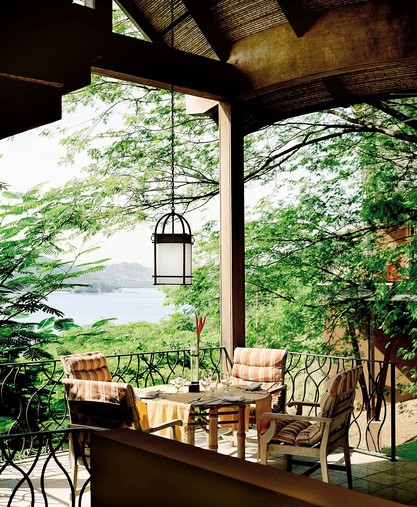
All that plays to
But that is yet another parallel to
In
One of the most delicious experiences was a conversation with Chef James whose much-traveled career has taken him all over the world and feeds his enthusiasm for what the food scene in
Entrée offerings such as cilantro-marinated grilled chicken with smoked bacon and cherry tomato vinaigrette, tuna niçoise salad, roast beef panini with grilled onions and blue cheese; and ciabiatta with prosciutto, fresh mozzarella, basil and olive tapenade aïoli. Sides of potato salad and black bean salad with roasted sweet corn papaya and local goat's cheese added ample fortification for snorkeling after lunch.
All that from a guy who began his culinary career washing dishes as a 10-year-old in a family restaurant in the
Just as in
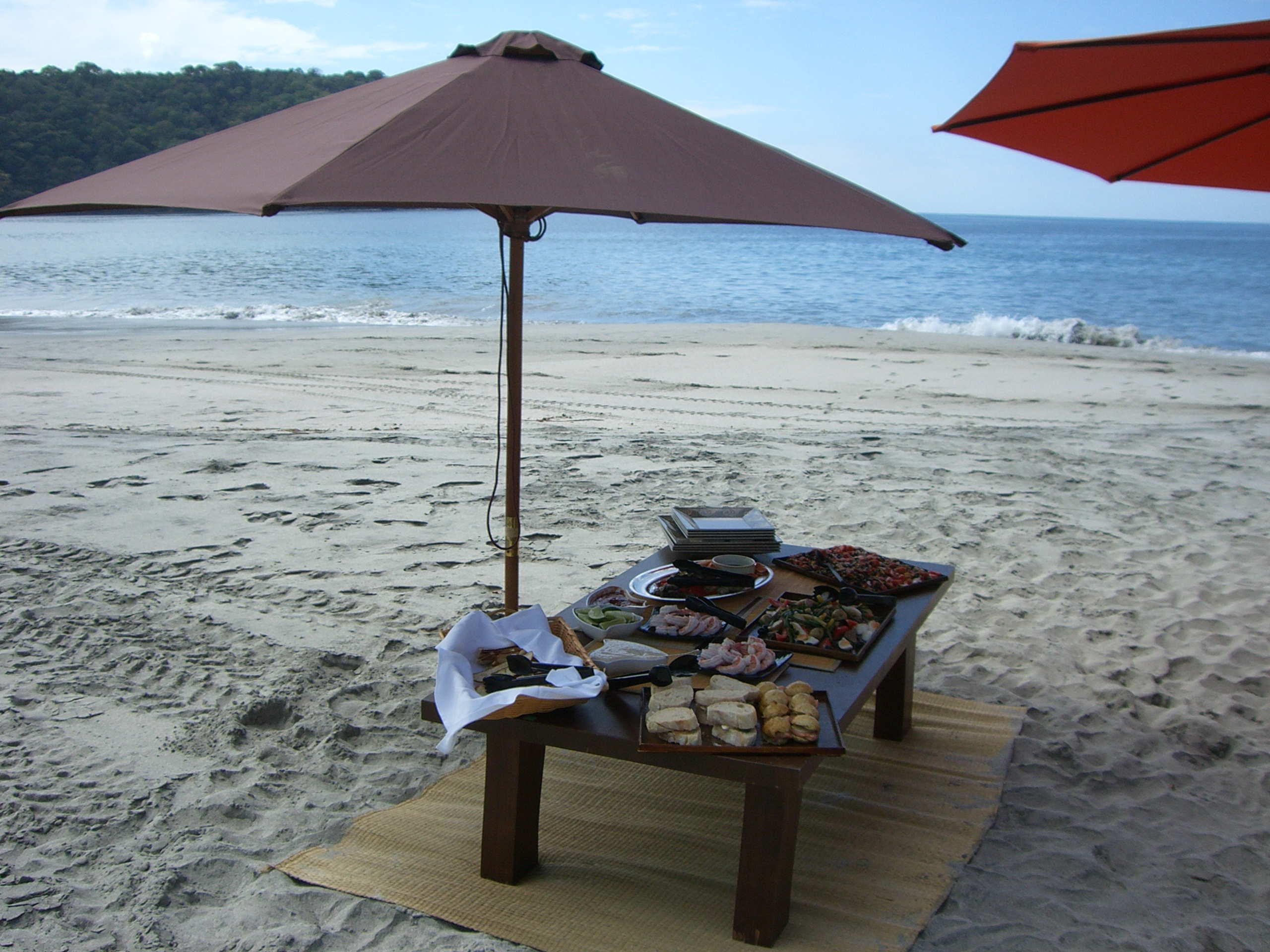 But
he’s become the Costa Rican equivalent of Johnny Appleseed. “You can
grow
anything here” because of the mild climate, says Cassidy. “When I got
here
there wasn’t even any romaine. I couldn’t put a Caesar salad on the
menu.”
But
he’s become the Costa Rican equivalent of Johnny Appleseed. “You can
grow
anything here” because of the mild climate, says Cassidy. “When I got
here
there wasn’t even any romaine. I couldn’t put a Caesar salad on the
menu.”Now growers are diligently producing custom products for Mr. Cassidy’s walk-ins, and local fisherman give him the pick of their catches. He drew on local suppliers for the dinner he prepared at the villa. The first course of tuna tacquitos with pineapple and serrano chili salsa offered a taste of Latin-influenced tropics.
Hamachi tiradito (similar to ceviche only the fish is cut into strips) with cilantro and mint mojito and jerk-seared sea scallop with Caribbean yellow curry also recalled the beauty of the country and the largess of the sea flavored by the country’s multi-cultural history.
Arugula and Guanacaste goat's cheese wraps with roasted red pepper, and macadamia nut and bacon dressing gave chef James a chance to show some of the local cheeses.
A main course of sea bass on a base of lobster, potato and chorizo picadillo, flavored with a hint of Costa Rican vanilla bean, chardonnay “air” (similar to foam), and a malbec syrup created a fitting grand finale to the symphony of local ingredients. Costa Rican cinnamon-flavored ice cream and warm chocolate cake finished off the evening as cool sea breezes blew in from the water.
The dishes reflect the chef’s growing understanding of foodways in
But much can be done. “This is the most incredible place I’ve lived,” he says noting that he’s now got a local maker of fresh goat's cheese. Street vendors selling handmade tortillas or fresh-squeezed juices have become suppliers for his restaurants or led him to suppliers.
When he travels Mr. Cassidy bring back seeds for herbs so he can grow what he wants. California chef Michael Mina will soon be doing a restaurant at a property across the bay. Listening to Mr. Cassidy talk about the growing culinary scene is like talking to a parent about his child. And that’s what he compares it to. “This is like having a baby, watching this thing grow. Its something we’re having a hand in shaping.”
Dotty Griffith is a writer, editor, and consultant in Dallas, Texas, and is former food editor of the Dallas Morning News. She also publishes the website The Critical Edge.
~~~~~~~~~~~~~~~~~~~~~~~~~~~~~~~~~
NEW YORK CORNER
By John Mariani
adour ALAIN DUCASSE

St. Régis Hotel
2 East 55th Street (near Fifth Avenue)
212-710-2277
www.adour-stregis.com.
I shall not yet again harangue Ducasse about his global vision except to say that he's had his flops (everyone does), which some might well suggest was due to his inattention and absence. He closed his last two New York outposts--his namesake dining salon at the Essex House and the more casual Mix--but he is now back with Adour, which is far more an example of a 21st century French restaurant than his fussy and pretentious Essex House restaurant ever was, a place where you were offered a half dozen knives with which to cut your food and as many pens with which to sign your very high check. As I recall, dinner at the Essex House ran $150 prix fixe, for three courses plus generous complementary amuses and confections, at a time when NYC French restaurants like Le Bernardin, Daniel, and Le Cirque were charging under $100. At Adour, named for a river in Ducasse's hometown), the appetizers run $17 to $29, the main courses $32 to $49, which is actually comparable to a steakhouse tab (where forty-five bucks gets you a sirloin with no potatoes). The tasting menu of five courses is a mere $110--which would not even buy you a main course in Paris. Prices are kept down by not dousing and stuffing every dish with foie gras and truffles, as is the rule in contemporary haute cuisine.
But Adour is far from low-rent Ducasse. Reports have been mixed about The Rockwell Group's decor, but I found it very beautiful, covering over the cavernous hotel dining room (formerly Lespinasse) with walls of elegantly appointed wine coolers and scrims that shimmer in the excellent, flattering lighting, although the central chandelier seems out of style here. Chairs and tables are well set, and in the posh bar (below) there is a remarkable computerized winelist that you merely move your fingers over to find a bottle to your liking, a device that reminded me of the info screens in the Tom Cruise movie "Minority Report." About 40 percent of the wines are French and an equal number American.
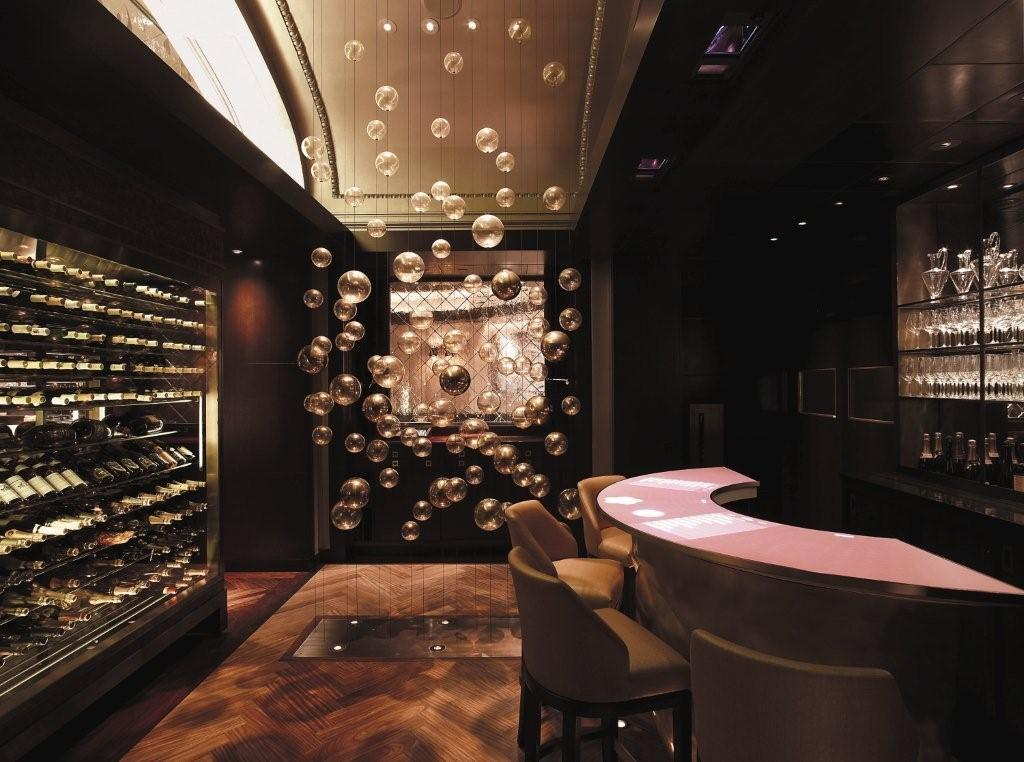 Service is polished,
friendly, and less
studied than in the old place, and the pace of the meal is ideal for a
civilized night out. I cannot, however, figure out why, since
opening this winter, Adour might offer you a table at 5:30 PM when upon
arrival you'll
find the place almost empty till about 7 PM and not full until after 8
PM. Unlike in France, where one seating each evening is the norm, Adour
turns tables, but at very odd intervals.
Service is polished,
friendly, and less
studied than in the old place, and the pace of the meal is ideal for a
civilized night out. I cannot, however, figure out why, since
opening this winter, Adour might offer you a table at 5:30 PM when upon
arrival you'll
find the place almost empty till about 7 PM and not full until after 8
PM. Unlike in France, where one seating each evening is the norm, Adour
turns tables, but at very odd intervals.And so, how does one eat at Adour? Very well, very well indeed, though at meal's end you may not be particularly giddy with delight or beg another rez too soon. This is pretty safe French cuisine, not so much simple as it is fairly predictable, delicious without being staggering. You begin with excellent breads and (for once) good olive-studded butter at the perfect temperature. NYC tap water comes in a lovely little ceramic pourer, and there are only enough knives designed for the specific job.
Chef Tony Esnault, who was the last of three chefs who'd worked at the Essex House restaurant, is a classicist who translates Ducasse's ideas on a menu that offers nine appetizers and ten main courses, all written entirely in English. A good number of the dishes are prepped in Sous-Vide, then finished as the orders come in.
Among the starters the sweetbread meunière (right) with wild mushrooms, a poached egg that oozes luxuriously when cut, and toasted brioche--is quite decadent in the nicest way--but not exactly generous with the sweetbreads. Sautéed duck foie gras was lusciously paired with a lentil casserole and a "belt" of sweet red onions. Cucumber vinegar marinated hamachi with a green apple mustard was very tame of flavor, the marinade too subtle, the mustard providing the only tang.
French chefs can never leave well enough alone when it comes to pasta, which can mean either an overwrought mess or an overly rich rendering: Adour's ravioli of foie gras with tapioca, chervil, celery, sunchoke in a consomme is flavorful, though the flavors don't do much for the foie gras or the sheer ravioli pasta.
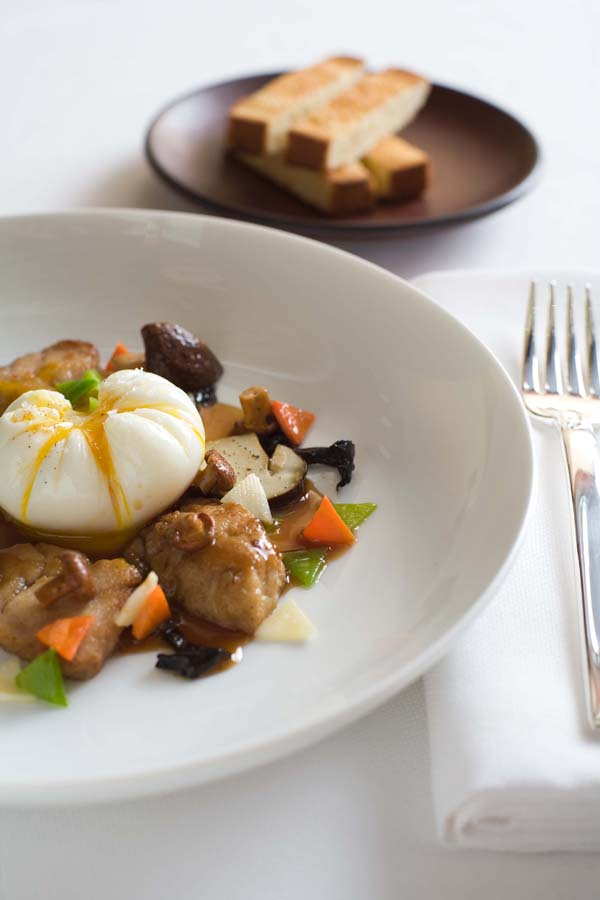
My scribblings in the margins of the menu range from "excellent!" for the olive oil-poached Chatham cod with a Bell pepper-white onion piperade with a pleasing intensity; scallops with salsify, black truffles, and shellfish jus, manifest the simple goodness of classic French cookery. "Very good" described Adour's version of that old 19th century cliché, lobster Thermidor--with a Swiss chard fondant and a dash of Armagnac; I can't say it was much of an improvement on the classic but it was damn delicious and it doesn't skimp on the butter and richness. Nevertheless it paled by comparison to one of the richest dishes I've ever eaten--glazed Berkshire pork tournedos with a golden apple ring, blood sausage, and juniper jus, whose every morsel was devastatingly good in a way that reminds me more of bourgeois cooking than haute cuisine. (This very popular dish, I'm told, will be staying put on the menu this spring.) Also quite good was a duck breast fillet "au sautoir" (a shape of sauté pan) with polenta, shallots, radish, lemon, and Niçoise olives, which hearkens to the Mediterranean flavors Ducasse has long favored at his restaurant in Monte Carlo. There is, however, nothing to get excited about with the roast Colorado rack of lamb--a skimpy rack at that--with piquillo peppers (mild), apricots (odd), creamy quinoa (trendy) and espelette (a French pimiento). The dish is just fine, but you can have something similar in any of a hundred New York restaurants.
Since you have not spent an exorbitant amount of money yet, you might as well splurge on the splendid cheese course offered at Adour, all in impeccable condition with appropriate breads and condiments. For dessert I was impressed by pastry chef Sandro Michelli's apple soufflé with Granny Smith compote, Calvados-laced lady finger, and vanilla ice cream, as I was with a rich serving of thin chocolate leaf layers with praline mousse and an orange-ginger sorbet. I wasn't thrilled with a funny-tasting pear clafoutis with caramel croustillant and honey ice cream, but my favorite sweet of one evening was dark chocolate sorbet with coffee granité and caramelized brioche croutons.
And so Ducasse has returned to NYC, if not yet triumphant at least with the potential for becoming so. Like his colleague Gordon Ramsay at his namesake restaurant in the London Hotel, Ducasse seems to be playing it safe with the menu at Adour at the St. Régis, at a time when there is so much excitement on NYC menus. And like Ramsay, Ducasse gives his restaurant only as much personal attention as he has time for as he trots the globe opening more restaurants (he's due to open a branch of Paris's Benôit in NYC this summer) and writing more cookbooks. In as many months Ducasse opened a three very grand restaurants, at The Dorchester in London, the spectacular Jules Verne in the Eiffel Tower, and Adour in New York, where he has spent time doing menu tastings on a fairly regular basis since opening. That he invests his restaurants with a highly professional and efficient brigade is obvious in the details, but like so many 21st century celebrity chefs his restaurants lack the spirit of the man himself, which is a very palpable virtue when dining out.
Adour is open for dinner nightly.
 AN ELEGY ON THE CLOSING OF WOLFIE
COHEN'S RASCAL HOUSE
AN ELEGY ON THE CLOSING OF WOLFIE
COHEN'S RASCAL HOUSEby John Mariani
"For a cast of Rascal House regulars, the end will come Sunday night, when the hallowed deli in Sunny Isles Beach closes its doors for good. Gone will be the red vinyl booths, the fabled corned beef sandwiches and stuffed cabbage, the cartoonish devil smiling impishly above the tattered green awning. "--The Miami Herald, March 29, 2008.
Oy, say it isn’t so that Wolfie’s gone,
The deli on Miami Beach bar none!
And tell me now where will its faithful flock
Now go to get a tasty hot kreplach?
For fifty-four good years it reigned supreme,
With bagels piled with lox and sour cream.
A place you’d go for liver chopped so fine,
And sour kosher pickles leave you cryin’.
To cure a cold the chicken soup will do,
To cure your broken heart some borscht for you!
And regulars will say what’s not to love
About the verdant grass soup that’s called shav?
In memory of the noodle pudding kugel
Blow loud and long and slow the gilded bugle!
No more the storied latkes of potato,
No more the cabbage sauced with lush tomato.
I know no better kishka of stuffed derma
In all of this wide, now sad terra firma.
I’ll dream of all those golden brown knishes,
And suffer pangs of hunger for smoked fishes.
The smell alone of hearty carrot tzimmes
That mingles with chuck steak and gently simmers!
The cholent! Flanken! Whitefish! Fatty brisket!
So many many people sure will miss it.
No blintzes stuffed abundantly with cheese?
Oh, tell me where to find their match now, please.
I may grow schmaltzy praising this and that,
But that’s what true schmaltz is—it’s chicken fat.
So Wolfie Cohen’s Rascal House is shuttered,
And no one sliced pastrami as they cut it.
So here’s to fifty-four delicious years,
Ah, what I’d give for just a few more schmears.
NOTES FROM THE WINE CELLAR
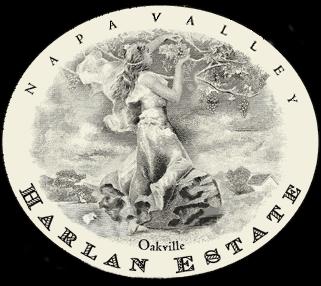 It’s Not Easy Being
a Cult Cabernet--Just Ask Harlan Estate
It’s Not Easy Being
a Cult Cabernet--Just Ask Harlan Estateby John Mariani
Now 68, Harlan had traded a very successful career at Pacific Union Real Estate.
Today, with only 2,000 cases produced annually, Harlan Estate sells every bottle a year or two in advance of release--70 percent by subscription, the rest to restaurants and winestores that beg to get a bottle or two. Even the most senior subscribers only get a maximum of six bottles and one or two magnums. This year Harlan sent 24 bottles through an importer to
“People are always cajoling us for wine,” says Harlan’s director, Don Weaver, 56, who recently showed the 2002, 2003, and 2004 vintages at Relais & Châteaux headquarters in

For subscribers the price for the current vintage, 2004 (which sold out before release) is $350. But if you could find the same wine at a store, internet site, or auction, it can run you $1,000 and up. At the 2000 Napa Valley Vintners Auction, a 10-vintage vertical selection of Harlan in magnums went for $700,000.
Weaver winces at the term “cult wine”: “We would like to be thought of as `blue chip.’ `Cult’ implies something trendy or off the beaten path. We are a fairly traditional, foursquare producer whose primary goal is to express the vineyard site faithfully each year. Even in different vintages, we want there to be a common thread.”
“Blue chip” certainly seems to fit Harlan’s current fans: “Fifteen years ago if you gave me 100 aenesthesiologists I could sell every bottle; now I need just ten guys from Goldman Sachs.”
What impressed me most about the wines Weaver showed in
I had neither the temerity nor expense account to beg Weaver to put me on his subscription list. Even when Bill Harlan’s son inquired about his “legacy bottles” upon arriving home from college, he was told there was very little old wine left in the cellar. “I wish we had stocks,” says Weaver. “We put away as much as we can, but there seems always a compelling reason not to.”
Which led me to ask Weaver if, oh, say, Charlize Theron showed up at Harlan Estate begging for a case of wine. Weaver smiled and said, “Well, I think I’d invite her in and we’d sit down over a bottle of wine and chat about it.”
John Mariani's wine column appears in Bloomberg Muse News, from which this story was adapted. Bloomberg News covers Culture from art, books, and theater to wine, travel, and food on a daily basis, and some of its articles play of the Saturday Bloomberg Radio and TV.
HOW'S THE FARE UP THERE?

Benji Fun offers "Dinner in the Sky" at a table suspended at a height of 50 meters, available for a session of 8 hours. Dinner in the Sky accommodates 22 people and three staff in the middle (chef, waiter, or entertainer). “Dinner in the Sky is an event that can be held anywhere (golf course, public place, race track, castle, vineyard, historical site…) as long as there is a surface of approximately 500 m2 that can be secured.”

UDDERLY RIDICULOUS
"Nancy Nipples started the Pike Place Market Creamery in Seattle 30 years ago, selling milk, butter, cream and the like to help local independent dairies. . . . (Nancy Nipples is the name she uses to sign checks; her full name, taken after a divorce, is Nancy Nipples the Milkmaid.)"--The New York Times.
[Not a photo of Nancy Nipples...but still weird]
QUICK BYTES
* From April 11-May 5 Disneyland’s California Food and Wine Festival, will hold winemaker dinners at Steakhouse 55, incl.April 11 – Chappellet Winery, Phillip Titus, Winemaker; April 18 – Twomey Cellars, Daniel Baron, Winemaker; , April 25 – Nickel & Nickel Single Vineyard Wines. Darice Spinelli, Winemaker; May 2 – Pride Mountain Vineyards, Steve Pride, Proprietor . . . . Also, Napa Rose Chef Andy Sutton will be hosting hands-on cooking classes with paired wines., April 12, 19, 26 and May 2.
* On April 15 in NYC, 67
Wine & Spirits and Tavern on the
Green present "A Napa Valley Experience with the Robert Keenan
Winery. Mike Keenan will be on hand to discuss 4 wines with 5-course
dinner and, in addition, to pour his Reserve Cabernet and Cabernet
Franc at a special tasting table. $109 pp. Call 212-873-3200;
www.tavernonthegreen.com.
* On April 18 NYC’s District restaurant’s executive chef Patricia Williams and general manager Marissa Barr are hosting their second Girls on Grapes event as part of an ongoing series of casual food and wine pairings ffor a flight of 6 wines paired with 3 courses of small bites. $35 pp. Call 212-485-2999.
* On April 21 in
Dallas, Nana will be
hosting a 5-course Domaine Chandon Wine dinner by Chef Anthony Bombaci,
with James Kress, winemaker. $150 pp. Call 217.761.7470 or visit
www.nanarestaurant.com.
* On April 23 Chef
Anthony Susi of Sage Restaurant in
Boston welcomes Ruffino Wines for a multi-course dinner
created around their Tuscan Estate wines. $85 pp. Call
617-248-8814; www.sageboston.com.
* From April 15-May 15 London’s Tamarai launches Singapore Month featuring a traditional drinks and dishes, culminating with Etihad Airways giving one lucky diner the chance to win a trip to Singapore. www.tamarai.co.uk.
* On April 15 the Bel-Air Hotel in Bel-Air, CA, will host a Domaine Carnberos dinner with Elaine Crane. $125 pp. Call Karla at 310.943.6742.
* On April 20 in Highland Park,
IL, Carlos’ Restaurant Owners Carlos and Debbie Nieto, with Rabbi
Susan Warshell, will host a special Passover Seder. Chef Ramiro
Velasquez will prepare a 7- course menu, priced at $90 pp or $130 with
kosher wine pairings. Call 847.432.0770.* In
* From April 24-27 the 6th annual St. Michaels Food & Wine Festival
* On April 27 the “Heart of a Chef Weekend” in
NEW FEATURE: I am happy to report that the Virtual Gourmet is linking up with two excellent travel sites:
Everett Potter's Travel Report:
Tennis Resorts Online: A Critical Guide to the World's Best Tennis Resorts and Tennis Camps, published by ROGER COX, who has spent more than two decades writing about tennis travel, including a 17-year stretch for Tennis magazine. He has also written for Arthur Frommer's Budget Travel, New York Magazine, Travel & Leisure, Esquire, Money, USTA Magazine, Men's Journal, and The Robb Report. He has authored two books-The World's Best Tennis Vacations (Stephen Greene Press/Viking Penguin, 1990) and The Best Places to Stay in the Rockies (Houghton Mifflin, 1992 & 1994), and the Melbourne (Australia) chapter to the Wall Street Journal Business Guide to Cities of the Pacific Rim (Fodor's Travel Guides, 1991). Click on the logo below to go to the site.
~~~~~~~~~~~~~~~~~~~~~~~~~~~~~~~~~~~~~~~~~~~~~~~~~~~~~~~~~~~~~~~~~~~~~~~~~
MARIANI'S VIRTUAL GOURMET NEWSLETTER is published weekly. Editor/Publisher: John Mariani.
Contributing Writers: Robert Mariani,
Naomi
Kooker, Suzanne Wright, John A. Curtas, Edward Brivio, Mort
Hochstein, Brian Freedman. Contributing
Photographers: Galina Stepanoff-Dargery, Bobby Pirillo. Technical
Advisor: Gerry McLoughlin
.
Any of John Mariani's books below
may be ordered from amazon.com by clicking on the cover image.
 My
newest book, written with my brother Robert Mariani, is a memoir of our
years growing up in the My
newest book, written with my brother Robert Mariani, is a memoir of our
years growing up in the For those of you who don't think of the Robert and I think you'll enjoy this very personal look at our --John Mariani |
 |
 |
 |
 |
 |
 |
© copyright John Mariani 2008

